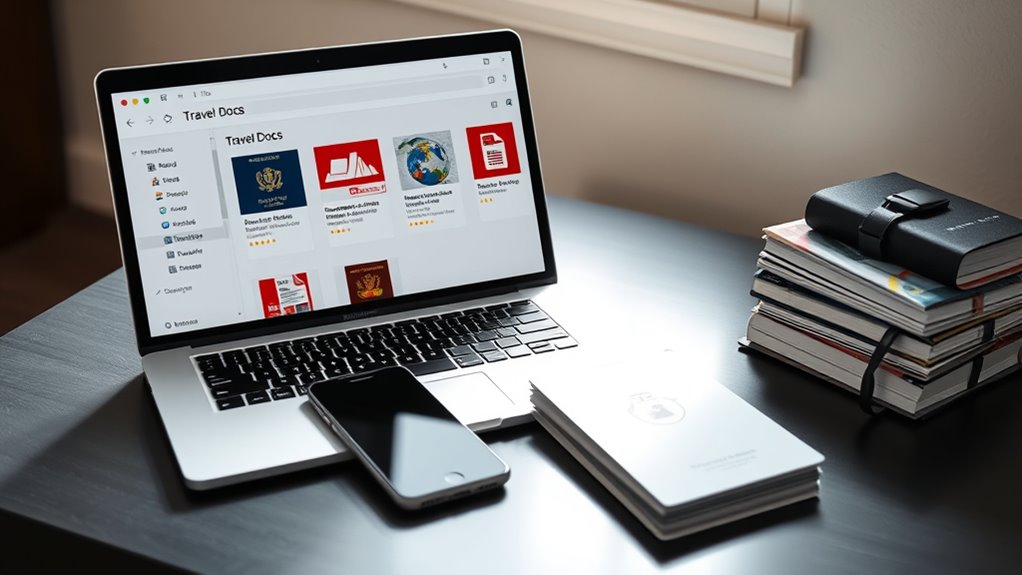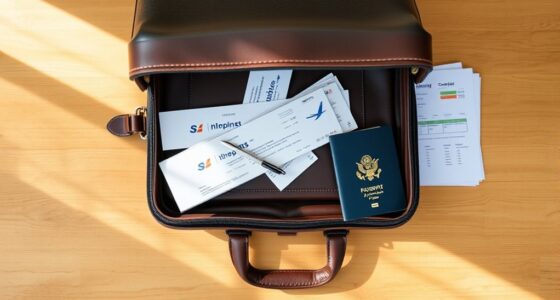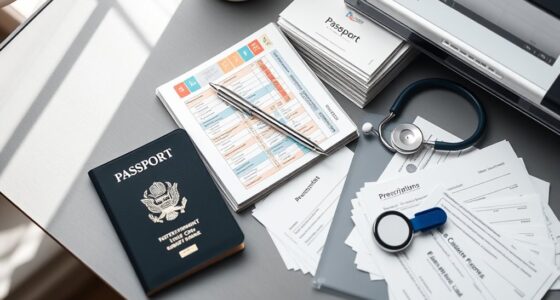To manage your digital copies of travel documents effectively, organize files with clear, consistent labels and store them in well-structured folders by trip or document type. Use reputable, secure cloud services with encryption and set up regular backups. Limit access with multi-factor authentication and keep files up-to-date by scanning new copies and reviewing them before trips. For quick retrieval, keep copies across devices and test access in advance—more tips await if you continue exploring.
Key Takeaways
- Adopt consistent naming conventions and organize files into clearly labeled, hierarchical folders for easy access.
- Store digital copies securely using reputable cloud services with encryption and regular backups.
- Enable multi-factor authentication and role-based permissions to control access and protect sensitive documents.
- Keep files updated and replace outdated versions; scan physical documents for quick digital access.
- Test retrieval methods before travel and keep copies on multiple devices or cloud platforms for quick access in emergencies.
Organizing Your Digital Files Effectively

To keep your digital travel documents organized, you need a clear system for naming and storing files. Start by adopting consistent file naming conventions—use clear labels like “Passport_2024” or “Visa_Italy_June.” This helps you quickly identify documents without opening each one. Store your files in organized folders, ideally sorted by trip or document type, for easy access. Cloud backup is essential; it ensures your files are safe even if your device is lost or damaged. Use descriptive folder names such as “TravelDocs_2024” or “Flights_and_Itinerary,” and maintain a logical hierarchy. Regularly update and review your folder structure to keep everything streamlined. Incorporating organized storage practices can also enhance your ability to recall important details during your trip. These practices make managing your travel documents simple and efficient, saving time and reducing stress during your trip.
Choosing Secure Storage Solutions

Selecting a secure storage solution is essential for protecting your digital travel documents from theft, loss, or unauthorized access. Cloud encryption is a key feature to look for, as it guarantees your files are protected both in transit and at rest. Opt for services that offer end-to-end encryption and strong security protocols. Additionally, implement effective backup strategies, such as regularly syncing your files to multiple secure locations or devices. This way, if one storage option fails, you still have access to your documents elsewhere. Avoid relying on unsecured or public networks; instead, choose reputable providers with robust security measures. By choosing storage solutions with built-in encryption and reliable backup options, you considerably reduce the risk of losing or compromising your travel documents. Maintaining awareness of security best practices ensures your sensitive information remains protected at all times.
Ensuring Privacy and Access Control

Making certain privacy and access control is essential for safeguarding your digital travel documents from unauthorized viewing or tampering. You should implement strong encryption protocols to protect data both at rest and during transmission. User authentication is necessary; use multi-factor methods to verify your identity before granting access. Here’s a quick overview:
| Security Measure | Description | Benefit |
|---|---|---|
| Encryption Protocols | Secure data with advanced encryption standards | Prevents unauthorized data access |
| User Authentication | Multi-factor login requiring credentials or biometrics | Ensures only you access documents |
| Access Control Layers | Role-based permissions and session timeouts | Limits exposure to potential breaches |
| Regular Audits | Periodic review of access logs | Detects suspicious activity |
| Secure Backup Storage | Encrypted backups stored safely | Protects data if primary access is compromised |
Additionally, understanding narcissistic behavior can help in recognizing manipulative tactics that may compromise your sense of security or privacy.
Keeping Your Documents Up-to-Date

Keeping your digital travel documents current is vital for smooth travel experiences and avoiding last-minute complications. Regularly updating your files ensures you have the latest versions and valid information. Start by scanning new or renewed documents, so you always have an up-to-date digital copy. Use photo backups to store clear images of your passport, visa, and other essential IDs, making it easy to access if needed. Set reminders to review and refresh your documents before each trip. Keep your files organized in a secure cloud account to avoid scrambling at the last minute. Remember, outdated documents can cause delays or denied entry, so staying current is indispensable for hassle-free journeys.
Tips for Quick Retrieval During Travel

To access your travel documents quickly when you need them most, organize your digital files logically and keep them easily accessible. Use clear folder labels and prioritize the most important documents, like your passport and boarding passes. Implement backup strategies, such as regularly updating copies on an external drive or cloud storage. Cloud synchronization is especially helpful, allowing you to access files from any device with an internet connection. Guarantee your files are stored securely and can be retrieved with a few clicks. Avoid clutter by removing outdated copies, and test your access method before departure. This way, you’ll save time and reduce stress if you need to locate your documents quickly during your trip.
Frequently Asked Questions
How Can I Verify the Authenticity of Digital Travel Documents?
To verify the authenticity of digital travel documents, you should check for a valid digital signature from a trusted authority. Look for document certification details embedded within the file, which confirm its legitimacy. Guarantee that the digital signature hasn’t been tampered with by using verification tools. If any doubts remain, contact the issuing agency directly to confirm the document’s authenticity, safeguarding yourself from potential fraud.
What Should I Do if My Digital Copies Are Lost or Corrupted?
If your digital copies are lost or corrupted, you should first consult your emergency recovery plan to restore access quickly. Keep digital backup strategies in place, like storing copies on secure cloud services or external drives. Always have physical copies as a backup. Contact the relevant authorities if needed, and consider using secure, encrypted storage for future digital copies to prevent similar issues.
Are There Legal Restrictions on Storing Digital Copies of Travel Documents?
Like a knight from a medieval tale, you might wonder if storing digital copies of travel documents is legal. Generally, there’s no law against it, but privacy concerns and digital security matter. You should guarantee your data is encrypted and stored securely, especially when traveling across borders. Be aware of country-specific restrictions on digital data, and always check local regulations to avoid legal issues with your digital copies.
How Can I Share My Digital Documents Securely With Officials?
To share your digital documents securely with officials, you should use strong encryption methods to safeguard your files during transfer. Additionally, set access control permissions to ensure only authorized individuals can view or use your documents. Avoid sending unencrypted files via email; instead, opt for secure file-sharing platforms that support encryption and access restrictions. This way, you keep your travel documents safe while sharing them efficiently and securely.
What Are the Best Practices for Backing up Digital Travel Records?
When backing up your digital travel records, you should use cloud storage for easy access and scalability. Make sure you apply strong encryption methods to protect sensitive information from unauthorized access. Regularly update your backups to include new documents and verify the security settings. Keep your encryption keys separate from your backups, and consider using multi-factor authentication to further secure your data. This way, your records stay safe and accessible when needed.
Conclusion
By organizing and safeguarding your digital travel documents, you’re building a sturdy bridge across the unpredictable river of travel. When every file is in its right place and protected, you hold the keys to smooth journeys and stress-free adventures. Think of your digital copies as your trusted compass—guiding you through unfamiliar terrain with confidence. With proper management, you’ll navigate travel with ease, turning chaos into calm and uncertainty into adventure.









